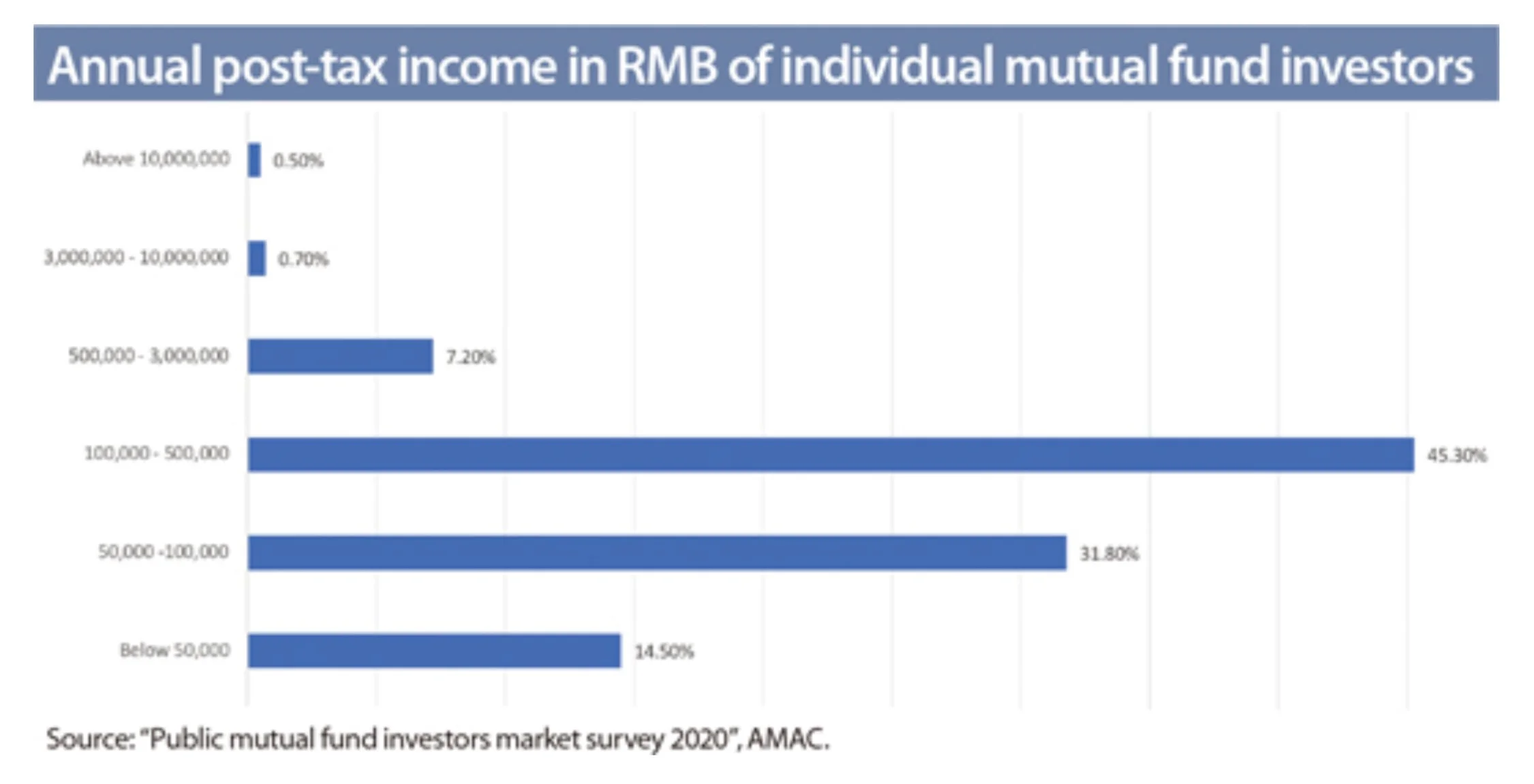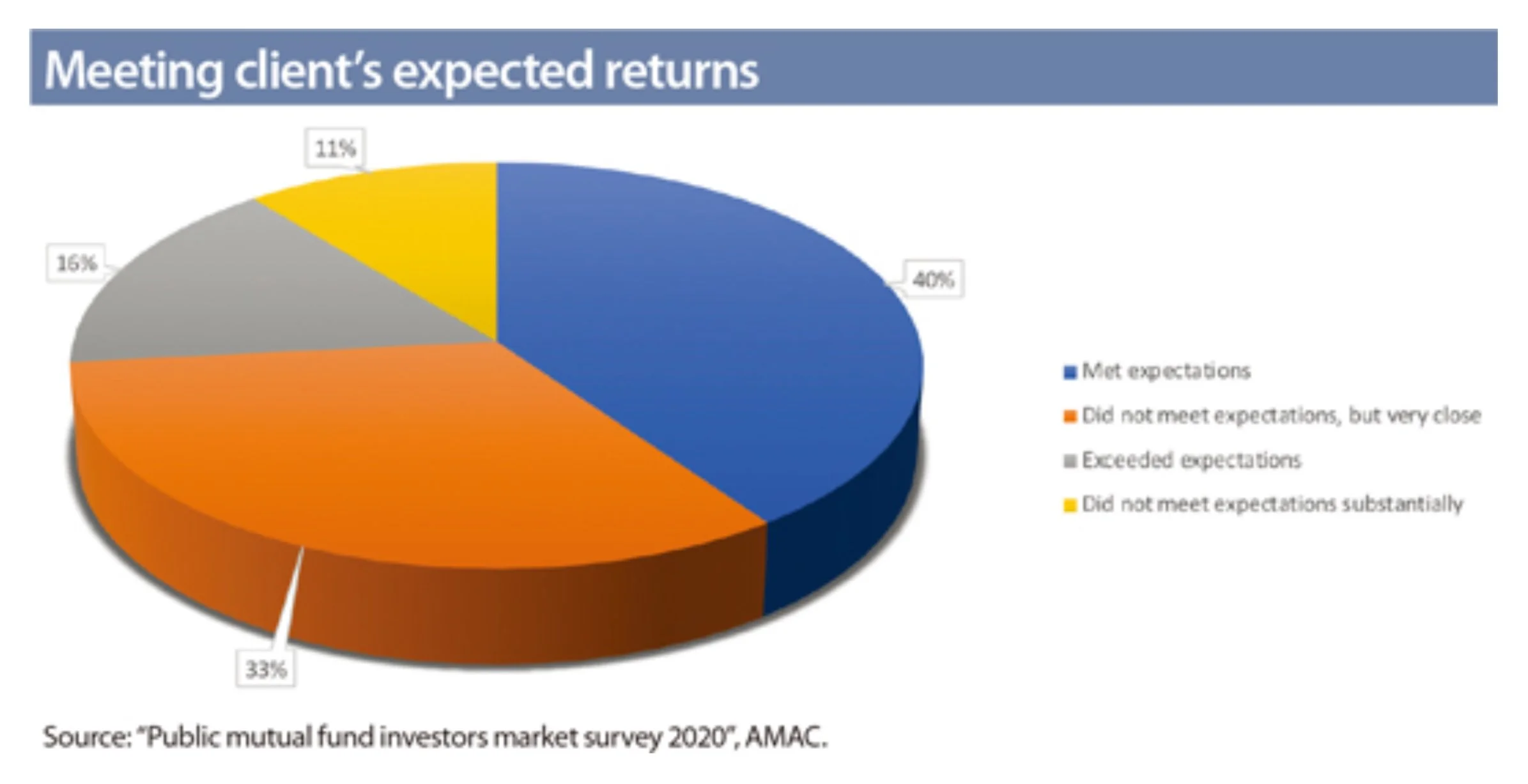The changing face of Chinese investors
Survey findings indicate China’s mutual fund investors are gaining confidence and maturity
Rising household wealth coupled with strong market performance is driving the growth of China’s mutual fund market, which surpassed 25 trillion RMB (US$3.9 trillion) as of November 2021 after blowing past the 20 trillion RMB mark in 2020. At the same time, an increasing number of investors are taking a more long-term view of investing alongside the maturing of the country’s mutual fund industry and its financial markets.
Over 53% of China’s public mutual funds were held by individual investors in 2020, according to an annual survey by the Asset Management Association of China (AMAC). More than 45% of these investors were in the 100,000-500,000 RMB annual post-tax income bracket, a sharp increase from 25.8% in 2016. And over 8% had annual post-tax income exceeding 500,000 RMB compared with just 3% in 2016.
AMAC has been conducting the annual survey in conjunction with its 160-member asset management companies for almost a decade. The latest survey was carried out between July and August 2021, with responses from 84,807 individual investors. The findings were published this January.
In 2020, over 46% of investors allocated more than 30% of their household income to mutual fund investments, a nine-point increase from 2016. Almost one-third, or 32%, allocated over 500,000 RMB, and 13% allocated more than one million RMB.
The total number of individual mutual fund investors in 2020 was nearly 670 million. By age, the biggest investor group was between 30 and 45 years old, accounting for 39% of the total. The second largest group (28%) was aged below 30, closely followed by those aged between 45 and 60 (26%). The over 60s accounted for the smallest share at 7%.
Male investors represented 54% of investors. But the share of female investors jumped ten points from 2016 to 46% in 2020.
A majority of investors, or 62%, had university education or higher, up from 50% in 2016. Three-quarters of investors claimed to have knowledge of financial investment, and 70% had more than three years of investment experience.
Geographically, investors were rather concentrated, with 35% located in Guangdong, Beijing and Shanghai.
Longer-term returns
Over half the investors allocated the largest share of their assets into bank wealth management products and bank deposits. Notwithstanding that, 74% invested in equity mutual funds, 55% in multi-asset funds, 44% in bond funds, 41% in index funds (excluding exchange-traded funds), and 23% in money market funds.
Almost 58% held five or more mutual funds in their portfolios for diversification purposes. One-quarter of all investors owned ten funds, depending on their financial resources and investment experience. Over 31% diversified their holdings with products from more than five mutual fund companies.
Investors are also showing greater confidence investing in mutual funds, with over 75% putting their additional income into mutual funds, or switching their bank deposits into mutual funds. Dollar-cost averaging was viewed positively by 71% of investors as a time-saving and effective way of investing while diversifying risks.
Increasingly, investors are aiming at returns in the longer term, with 56% holding a fund for more than one year on average, up 13 points from 2016. Some 35% of investors held their funds for one to three years on average.
Almost three-quarters of investors said they would not closely monitor the profits and losses of their funds, or only do so occasionally. Only 11.5% said they would regularly review and make changes.
Fewer than 8% said they would feel anxious with an investment loss of less than 10%; the share jumped to 34% when the loss increased to 10%-30%.
Investors’ attitude towards risk and return was balanced, with more than 55% accepting that they would take some level of risk in order to generate returns. And over one-quarter of investors accept that high returns require taking higher risk, up four points from 2016.
However, many investors maintained the same opportunistic mentality in stock trading for mutual fund investing. Given five scenarios to buy into mutual funds, more than two-thirds, or 67%, said a down market was an excellent opportunity to buy funds because they could bottom-fish, while 44% thought it’s best to buy during an up market to ride on the surge. (Figures add up to more than 100% as respondents were allowed to select multiple options.)
The survey has some encouraging feedback for the mutual fund industry. Close to 90% of investors said their fund returns had exceeded, met, or come close to expectation; 40% said returns had met their expectations. That’s a very solid endorsement.
The biggest drivers for investing in mutual funds were saving for retirement or education, cited by three-quarters of investors. By contrast, more than half the investors in 2016 were in search of better returns than bank deposits, with only 32% investing to save for retirement and education.
More sophisticated
There are also indications of a rising level of investor maturity and sophistication. Investment decisions could be influenced by multiple sources, but an investor’s own judgement was the over-riding factor, cited by 72%. This was followed by recommendations from online platforms and financial media (47%), friends (45%), and fund management companies and banks (43%).
Investors considered multiple factors when they evaluated fund products. But five factors stood out with scores between 84%-90%: past fund performance, ranking and investment ability of the fund manager, investment strategy of the fund, size of the fund management company, and ease of transacting.
By contrast, the three most important factors in 2016 were past fund performance (45%), reputation of the fund management company (20%), and whether the company has foreign shareholding (11%).
Almost 90% of investors in the latest survey showed interest in new thematic investments such as carbon neutral funds, real estate investment trusts, target return pension funds and new technology funds. And 30% have invested in these products.
They used multiple sales channels to purchase funds, including banks (46%), direct sales channels of fund management companies (44%), securities companies (42%) and independent channels (37%).
Digital and online media are making a big impact on investor communication with 60% of investors aged below 45 pointing to direct streaming, short videos, and other forms of communications through digital media as their most important source of investment information. Other forms of online communications accounted for over 45% in importance among all age groups below 60.
Seminars and in-person discussions accounted for around 40%. Traditional means of communications through printed media, books and publications were of lesser importance to those younger than 45.
China’s mutual fund industry has made big strides over the past two decades since the first open-ended fund was launched in 2001. The industry is now the largest in Asia Pacific and the fourth largest in the world after the US, Luxembourg and Ireland. That’s a big jump from ninth spot in 2016.
A caveat
The profile of individual mutual fund investors is clearly evolving. Female participation has increased, incomes are higher, and investors are more educated, savvier at online and digital communication, and allocating more income into investment. They are also taking a longer-term view on returns, showing interest in new investment ideas, accepting reasonable risk for higher returns, and saving for retirement and education.
Increasingly, they display stronger confidence and maturity in investing and more sophistication. This is a result of education efforts by the industry, regulators, investors themselves, and the supporting ecosystem.
However, 2020 was a bumper year for mutual funds with the industry growing 36% from 2019, which must be taken into account when interpreting the survey findings. It will be interesting to see whether the positive results hold up when it comes to a year with market difficulties.
*This article was published in Asia Asset Management’s February 2022 magazine titled “The changing face of investors”.





